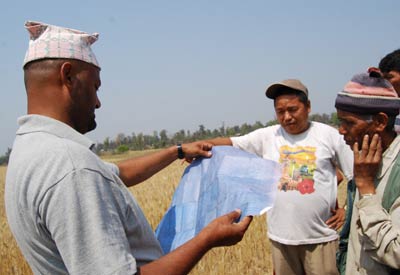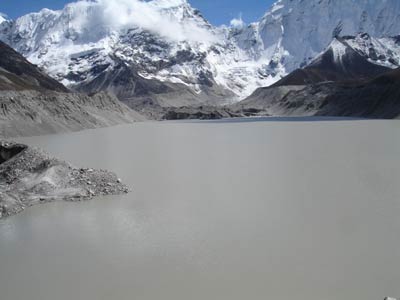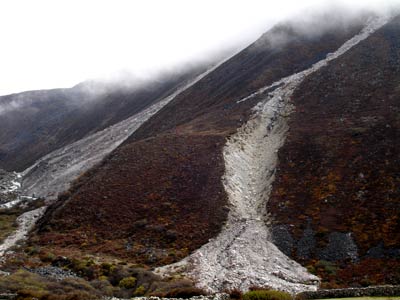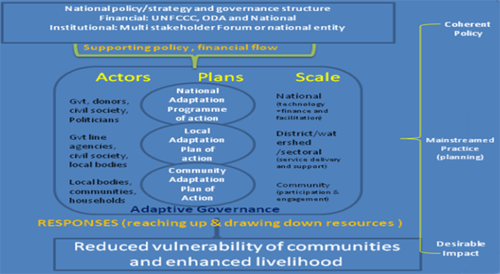  |
Bimal Regmi and Ramu Subedi consider the lessons of the National Adaptation Programme of Action process in Nepal and the role of local and community-based planning. |
| The experience has been encouraging, showing potential to address some of the issues emerging in mainstreaming climate change adaptation in development. Due to a lack of supportive governance structure, though, these initiatives may not be sustainable in future and there is a need for further work on crafting climate change adaptation architecture that is based on multi-stakeholder engagement. | |
| Bimal Regmi is a Phd scholar at Flinders University, South Australia. Ramu Subedi is a project manager with the Multi-Stakeholder Forestry Programme in Nepal. | |
The National Adaptation Programme of Action (NAPA) process was mandated by the United Nations Framework Convention on Climate Change in the Marrakech Accords of the 2001 with the intention of mainstreaming climate change adaptation planning within national development planning in Least Developed Countries. Some years on, there remain outstanding issues regarding the integration of NAPAs within national plans. The NAPA process is often not well incorporated into either adaptation planning or in national development strategies and there are structural issues that hamper better alignment between climate change adaptation and the national planning process.
For example, Saleemul Huq and Mizan R Khan, writing in Fairness in Adaptation to Climate Change (published by MIT, 2006), argue that most NAPA preparation to date has been based on externally-driven development planning. Balgis Osman-Elasha and Tom Downing (Tiempo, Issue 65, October 2007) conclude that NAPA preparation in many countries had been problematic because of the linear, top-down, sectoral approach that has been adopted. There are grey areas as to how NAPAs address local concerns and the role of local actors and communities in the planning process. Current NAPA Guidelines only consider sectoral and centralized planning and are silent on local participation and involvement.
Nepal is taking lead in identifying and devising appropriate mechanisms and frameworks to address issues around operationalizing adaptation policies and programmes with innovative work focused around piloting local and community-based adaptation plans to establish functional relationships and synergy with the Nepalese NAPA. This mechanism of linking bottom-up and top-down planning is an opportunity to address the mismatch in planning and create coherent adaptation responses that are flexible, innovative and responsive.
In practice, however, there are challenges in addressing some of the dilemmas around wider adoption and scaling up of these initiatives. Policy makers and practitioners need to be aware of these developments and implications for the overall governance of climate change issues. It is critical for the government of Nepal and Nepali stakeholders to think of planning adaptation architecture well ahead to address effectively climate impacts.
This article seeks to highlight some of the issues emerging from the early development of adaptation planning in Nepal and its innovations as well as some of the issues surrounding the governance of planning. There is rich information and knowledge regarding the process adopted in Nepal that will be of relevance to other countries. The information and analysis carried out in this article is based on experience of the NAPA project, Local Adaptation Plan of Action piloting supported by the United Kingdom Department for International Development and the Livelihoods and Forestry Programme initiative on community-based adaptation planning.
Mainstreaming adaptation planning
Development planning has always been debated in terms of its effectiveness and inclusion. Top-down or blueprint planning has been criticized as imposed and centralized, often ignoring the role of communities and other stakeholders in planning, by many scholars who believe in participatory planning. There is a large body of literature on why state-centric and technocratic planning has failed to deliver its promises.
Still, in a country like Nepal, political decision-making is characteristically centralized in the capital Kathmandu with a top-down approach. To the contrary, civil society advocates for participatory and community-based planning as an effective tool for development. Although the door has been opened for participatory planning at the local level, this is limited by government bureaucracy and government influence. The participation and inclusion of stakeholders is rarely practiced. Many projects and programmes designed by government often resulted in ineffectiveness due to lack of community ownership and support.
There is a growing body of literature on planning from the community level, inspired by social movements and non-governmental organizations (NGOs), that aims to initiate institutional reforms that enhance the quality of life of disadvantaged groups. This bottom-up planning involves communities at the centre of planning and making decisions about their future. It is widely adopted in community-based natural resource management.
The Community Forestry Programme, which rests on communities' leadership in planning, is a successful model in Nepal and elsewhere. Nevertheless, while there are success stories in some areas, there are difficulties in others. There are constraints to community-based or bottom-up planning due to issues around power imbalances, exclusion and benefit sharing. Although community-led or bottom up planning may successfully developed community ownership, it can fail to draw down resources and technical support from the government. It may be constrained due to isolation, lack of support and a lack of wider scaling up.
The crux of facilitating adaptation lies in how well communities are involved in the local level planning and delivery process and what is their level of ownership. Although global and national debate is very important in terms of strategically devising policy and financial resources, the local governance mechanism and system is equally important for facilitating adaptation. As resources start to flow, there is a need to ensure that system is in place and ready to make best use of these resources. In order to make the system work, we need transformative changes in the mindset of both the policy makers and the practitioners.
Case study one: Attempt to promote inclusive and integrated National Adaptation Programme of Action
National Adaptation Programmes of Action aim to build the adaptive capacity of the most vulnerable communities in the most vulnerable countries through the identification and development of specific measures aiming at reducing vulnerabilities to climate change of the different groups and sectors. They provide a process by which to formulate a national climate change adaptation agenda. Nepal considers the NAPA as a strategic means to mainstream climate change adaptation in development programmes. The Government of Nepal took the leadership in facilitating an inclusive and participatory process in the preparation of its NAPA.
The Ministry of Environment, the Government of Nepal's focal agency for climate change issues, coordinated with United Nations Development Programme Nepal in the preparation of the NAPA, complemented by idea of NAPA Plus. NAPA Plus is a strategic long-term programme that aims to enable priority activities identified by NAPA to be mainstreamed in country development planning as well as ensure effective implementation of adaptation responses. Support from the Embassy of Denmark and DFID enabled the Government of Nepal to undertake an extensive nation-wide consultation process and to use the NAPA process as a strategic platform and mechanism for enhancing knowledge management and developing a multi-stakeholder framework of action in mainstreaming climate change adaptation.
The Ministry of Environment facilitated the establishment of thematic working groups to carry out the tasks required in the development of the NAPA. The thematic groups were sectoral in nature (focused on agriculture, forestry, water, infrastructure, health, gender and governance), and were comprised of representatives from different sectors, including local and international NGOs, business associations, and United Nations agencies. A total of 80 organizations was directly involved in the preparation of the NAPA document as members of the working groups and the work of the thematic working groups was supported by a wider reference group. The involvement of multiple stakeholders and a multidisciplinary team helped ensure a comprehensive document and greater ownership. The consultation on the document ranged from the public and grassroots level to policy makers. Overall, more than 200 national and international agencies and 3000 people were involved in the NAPA drafting process.
The preparation of the NAPA took into account the diversity of the country's ecosystems. Transect exercise was conducted by the members of the thematic working groups to quickly assess the issues through facilitating local- and district-level field visits and interaction with communities and local stakeholders. This was complemented by detailed vulnerability assessment and mapping using both participatory as well as GIS mapping.
NAPA is also geared towards promoting the mainstreaming agenda and integrating adaptation into the overall national development process was a major consideration from the very outset. Hence, the National Planning Commission was engaged in all steps of the NAPA process. As a result, the Government of Nepal's Three Year Plan Approach Paper - the document defining the nation's medium-term national development priorities - has made a clear reference to the NAPA and to the imperative of ensuring that new development projects and programmes are screened from the point of view of climate change vulnerability and risk reduction.
The Cabinet endorsement of the NAPA in September 2010 signals that the NAPA is fully owned by the national government. The NAPA process in Nepal has taken a unique approach by learning lessons from the development of NAPAs elsewhere. It combined the bottom-up and top-down approach to create awareness, build capacity, develop plans and mobilize stakeholders' interest in climate change issues. The preparation of the NAPA document, which is the centrepiece of the NAPA project, was also used in Nepal as a launching pad for the development of a climate change knowledge management platform and a multi-stakeholder framework on climate change action.
 |
|
Farmers participating in adaptation planning
© Bimal Regmi |
The government has focused on strengthening the information and knowledge base on climate change. The Nepal Climate Change Knowledge Management Center has been established with the Nepal Academy of Science and Technology as the host institution. The Ministry of Environment has also formed the Multi-Stakeholder Climate Change Initiatives Coordination Committee, a coordination body at the functional level that complements the policy-level coordination of the Climate Change Council. Finally, awareness raising and capacity-building initiatives were organized by NAPA to generate interest and enthusiasm on climate change related issues.
As far as the future is concerned, there are issues regarding the continuity of NAPA process and keeping the thematic working group and wider stakeholder structures intact and engaged. At the time of writing, the NAPA project has just been completed and the government and Nepali stakeholders have not come up with any plans to continue the initiative. It would be valuable for development agencies and government to promote the mechanism and framework established by the project. Building on its achievements and good practices will lead to successes in the future in terms of ensuring multi-stakeholder participation in facilitating adaptation responses.
Case study 2. Innovations around the Local Adaptation Plan of Action
The Local Adaptation Plan of Action (LAPA) emerged as one of the innovative mechanisms linking community and national adaptation planning and responses. It is a bottom-up approach that enables communities to understand changing and uncertain future climatic conditions and engage effectively in the process of developing adaptation priorities. It implements climate resilient plans that are flexible enough to respond to changing climatic and vulnerability conditions and informs sectoral programmes and catalyzes integrated approaches between sectors.
The United Kingdom Department for International Development supported development of the LAPA framework, which is based upon the principles of inclusiveness, responsiveness, flexibility and iteration. HTSPE, the International Institute for Environment and Development and local NGOs were involved in LAPA piloting. The information presented here is drawn from the NGO pilot reports and informal consultation with individuals involved in piloting.
The LAPA framework responds to the challenges posed by climate change to development planning and achieving equitable development outcomes. The LAPA process addresses how to plan under climatic uncertainty for the different impacts affecting local people. The intention is that use of the LAPA framework will help local-level decision makers (households, community-based organizations and public bodies at the village and district levels) to prepare local adaptation plans and to present these plans for inclusion in development planning processes by Village Development Committees and District Development Committees.
The early lessons from LAPA piloting indicate that it is proving effective in overcoming barriers in adaptive governance. It has contributed to raising awareness and the capacity of communities and local institutions to take leadership in designing adaptation responses and responding based on available resources. Community leadership and ownership of the adaptation process is key to LAPA. The local adaptation planning process has successfully linked community-based adaptation with the national adaptation planning process, providing a framework and mechanism for facilitating a top-down and bottom-up mix of adaptation responses.
Local adaptation planning and the framework around adaptation governance in Nepal are providing good examples and lessons in support of the current discussion of the adaptation paradox - how to link global policy making to local responses. It is also helping Nepal to take leadership in demonstrating local preparedness and actions towards climate change adaptation governance. Although the pilot activities are in an early phase, there are already encouraging results; existing mechanisms are so far proving effective at mainstreaming climate change adaptation at the local level.
Several field pilots have identified a wide variety of tools that can be effectively used to assess climate vulnerable households or communities. The participatory tools and methods proposed by various agencies and scholars have been refined and adopted during LAPA piloting as a basis for integrated vulnerability assessment. Social analysis system tools that emphasize collaborative enquiry and social engagement, such as problem dynamics (assessing climate change issues), option domain (identifying adaptation options) and multi-stakeholder brainstorming workshops, were liked by communities, not least as they provided a visual basis for communities to understand and interpret the situation. Social analysis tools, such as those available through the Social Analysis Systems approach, were received well by NGOs and government officials due to their applicability and usefulness in terms of understanding power dynamics, institutional settings and differences among risk and adaptation thresholds. These lessons suggest that integrated vulnerability assessment can be an effective entry point to the LAPA planning process.
The pilot projects identified awareness raising, local capacity building, a participatory and inclusive process of planning and delivery and collaboration among communities, NGOs and local government bodies as important elements in shaping local adaptation governance and the effectiveness of the adaptation response at the local level. One of the crucial lessons is that more inclusive approaches will reduce conflict; though even then it may not be possible to include or incorporate all the different perspectives and stakeholders, especially in light of local political pressures.
The LAPA experience showed that a range of institutions are relevant for local adaptation planning, relative strengths and weaknesses for playing different roles depended on context. Local government agencies were identified as having the most potential among others for matching top-down and bottom-up climate change planning. Recognition of existing local institutions and mechanisms for sharing risks and benefits could be a good starting point for developing adaptive responses. Regarding technological innovations, existing systems and practices need to be built on. The degree of robustness in relevant systems and relative strengths and weaknesses need to be studied and understood. Facilitating the exchange of information and knowledge among communities and groups will be a powerful means of fostering the adaptive capacity of communities.
 |
|
Imga Glacier Lake
© Bimal Regmi |
One challenge lies around monitoring and evaluation. The initial LAPA pilot worked with partner organizations to develop monitoring and evaluation guidance, piloting some of the approaches and identifying a framework. Early lessons suggest that outcome-based monitoring is relevant for improving adaptive capacity and improving climate change governance. The pilot also suggested that cost benefit analysis can be a strong decision support tool for the identification and prioritization of climate adaptation measures and development plans, and also to draw-down resources to reach out to the communities or households most vulnerable to climate change.
LAPA is still in its early stages. The government of Nepal is interested in the agreed framework for LAPA to drive the adaptation mainstreaming agenda. LAPA ownership by local government is critical to this agenda. It would be desirable to work with other sectors and stakeholders to look for potentials and opportunities to upscale LAPA learning across different watersheds and geographical areas in Nepal.
 |
|
Impact of glacier lake outburst flood
© Bimal Regmi |
Case study 3. Facilitating community-based adaptation planning
With support from DFID, the Livelihoods for Forestry Programme (LFP) has recently begun to support local communities to develop their adaptive capacity through Community Adaptation Planning (CAP) using existing mechanisms such as community forestry groups and public and institutional land management groups. CAP is a process through which the vulnerable and poor households within communities get involved in assessing their vulnerability situation, identifying adaptation deficits and planning for response and preparedness to deal with adverse impacts of climate change. It is a process under the Local Adaptation Plan of Action. Rather than creating a new mechanism, LFP has been using existing mechanisms to develop community adaptation planning in support of the most vulnerable people and communities.
Significant progress has been made in capacity building and CAP development in the LFP project districts. Almost 1000 capacity building events have been organized for more than 43,000 participants, including community members, students and the staff of various organizations. The capacity of more than 500 local facilitators or community practitioners has been enhanced on community action planning and climate change and staff from LFP, local NGOs, District Forest Offices and the Federation of Community Forest Users, Nepal have been involved in the CAP facilitation process. Though a specific tool was not used to measure the effectiveness of the capacity building efforts, observation during the CAP development process and discussions indicated that there was a significant increase in understanding of climate change among the various stakeholders. So far, a total of 978 CAPs have been developed covering 223,963 households.
According to a recent review of the process by LFP, local community interest in climate change, as an evolving issue that directly affects them, is high but communities need simple tools and techniques with local examples for effective planning. Adaptation planning is an ongoing process and should be treated as action research. It is not only related to the forestry sector, thus needs expertise from other sectors as well. Finally, leverage of funds is possible but needs strong coordination and regular communication for which community capacity in communication and leadership should be developed.
There seems to be some overlap between community-based adaptation planning and the local adaptation plan of action process and it is time to bring clarity in terms of scope and focus. Community-based adaptation planning should be the process for developing local adaptation plans of action. It is the bottom-up process that gives ownership to communities to assess and plan their adaptation needs, providing a basis for preparing local-level adaptation plans. The local adaptation plan should provide timely feedback and build coherence with national and sectoral adaptation plans.
Discussion
Evidence suggests that policy and programmes will not necessarily translate into effective adaptation action. Thus, a major challenge concerns the lack of an effective roadmap and governance architecture to meaningfully address climate change impacts, particularly at local levels where a mismatch between national planning and local action has been noted.
Success in adaptation lies in how well plans are designed and delivered on the ground. Design and delivery has to happen in continuous manner. If resources start flowing to the least developed countries, there are fundamental issues around governmental efficiency in managing the funds, access of vulnerable households to the funds, governance of management and monitoring and evaluation. There is growing concern that, due to lack of institutional and financial architecture in adaptation financing and governance at the national level, action on adaptation might be ineffective and the target population may not receive any direct benefit. The current structure and governance of fund channelling and programme implementation is not that favourable. The current development structure relies on sectoral response and this is a challenge to adaptation. The issues around governance of development interventions demand mainstreaming approaches in development planning that can open space for adaptation.
Nepal offers unique opportunities for addressing the mismatch in planning by innovating and experimenting with local governance and planning mechanisms. There are good initiatives in Nepal regarding the planning deficit and ways to integrate and mainstream climate change adaptation at the local level. The transformation that has begun linking community-based adaptation planning with local development and national planning will be a milestone to drive institutional and policy changes to address the adaptation deficit.
 |
| Framework for mainstreaming climate adaptation in Nepal |
Adaptation planning can also be an opportunity to address issues around coordination and fragmentation by aligning policy and programmes to join up action against climate change impacts. Multi-stakeholder engagement is needed and state leadership should allow communities to reach up and draw down resources. Central to the discussion is not the adaptation plan itself but the process through which various actors come together and forge strong alliances and networks for collective action at different scales. The figure above outlines the conceptual framework of mainstreaming adaptation planning; this needs to be tested further.
The current literature on mainstreaming climate change adaptation and development recognizes the importance of further research and study in this area. The science of adaptation is new and emerging. There are limitations in terms of available information on adaptation planning and related issues. Adaptation is an urgent issue for the least developed countries like Nepal and thus generating information and knowledge is vital in promoting the mainstreaming agenda. Practical and workable ways for developing policy, strategy and framework both at national and local levels are of significance in addressing the urgent and immediate adaptation needs of the most poor and vulnerable communities. Research into the effectiveness and relevance of this planning process should be a significant contribution to global discussion regarding facilitating adaptation.
Conclusions
It is time to think more strategically regarding devising an adaptation planning architecture that will address the fragmentation of planning mechanisms and overlap within development and adaptation communities. It is hoped that the architecture of a top-down and bottom-up mix of planning discussed here will provide some answers and a way forward.
The framework is practical in that it links the community's needs with local and national priorities and support. It recognizes the role of various agencies, including communities, in shaping the decision-making process by empowering the actors to own the process and to actively contribute based on their comparative advantages.
The framework also recognizes the intrinsic link between enabling and coherent policy and a mainstreamed planning process that will lead to desirable outcomes; it helps policy makers and the development community to take appropriate decisions to scale up the proposed adaptation planning framework and mainstream it in the national development process. If this is successful, then it will smoothly and effectively drive the mainstreaming agenda in poor, developing countries like Nepal. Advancing Nepal's leadership in timely action on climate change adaptation could provide valuable lessons for other least developed countries.
Further information
Bimal Regmi, Phd Scholar, Flinders University, South Australia, Australia. Email: regm0003@flinders.edu.au.
Ramu Subedi. Email: r-subedi@msfp.org.np.
On the Web
The National Adaptation Programme of Action for Nepal and related reports are available online. The Tiempo Climate Cyberlibrary lists articles and selected websites on adaptation, National Adaptation Programmes of Action and Nepal.